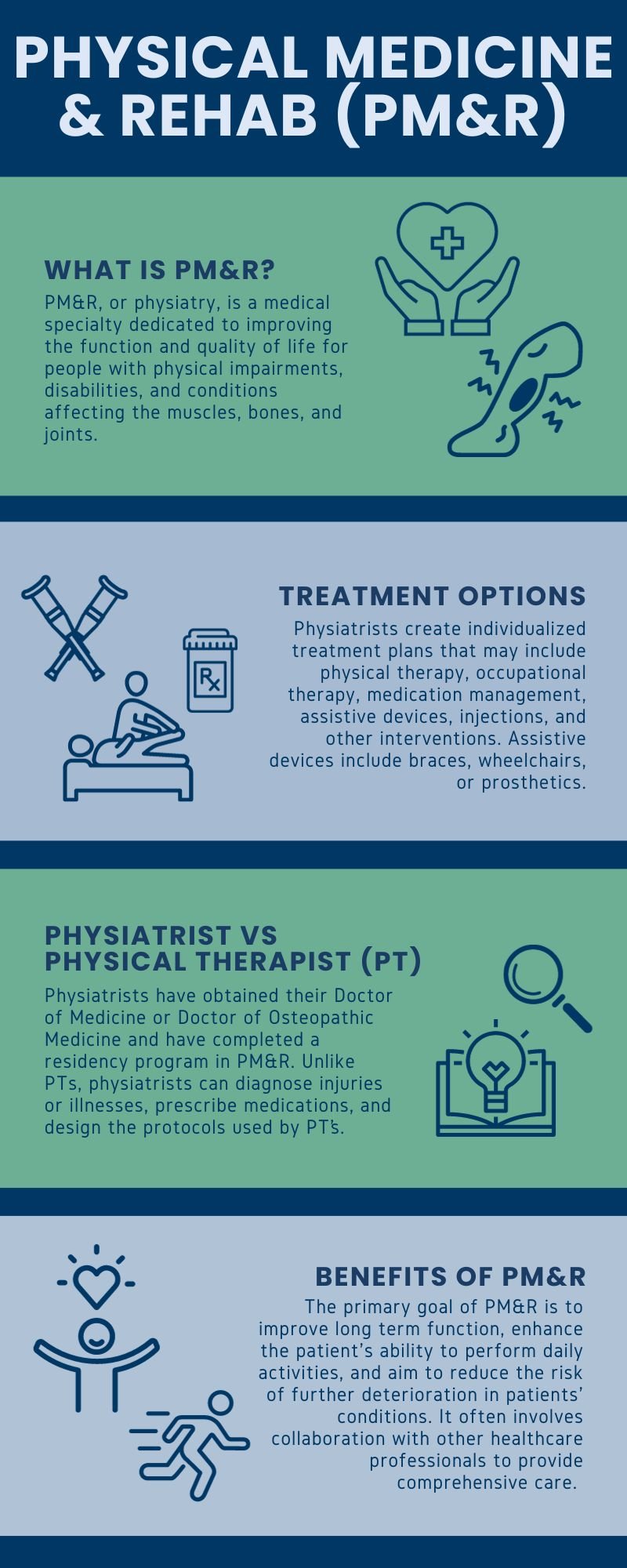Physical Medicine & Rehabilitation

Physical Medicine & Rehabilitation specialists focus on restoring function to those suffering from physical ailments or disabilities affecting the brain, spinal cord, nerves, bones, joints, ligaments, muscles, and tendons. Also referred to as Physiatrists, Physical Medicine & Rehabilitation specialists aim to provide specialized treatment plans to help patients of all ages regain their quality of life. Physical Medicine & Rehabilitation takes a multi-faceted approach to evaluate each individual patient and determine how their current impairment(s) affect different aspects of their life. While Physical Medicine & Rehabilitation specialists may not completely eliminate a patient’s pain, Physiatrists maximize physical function while greatly decreasing the patients pain and attempting to avoid surgery.
With offices in Dallas, Arlington, Irving, Midlothian, Waxahachie, and Mansfield, the Physiatrists at AOA Orthopedic Specialists helps patients all across the DFW Metroplex get the comfort and quality of their lives back everyday.

Should I see a Physical medicine & rehabilitation specialist?
Do not confuse Physical Medicine and Rehabilitation with Physical Therapy. Physiatrists have obtained their Doctor of Medicine or Doctor of Osteopathic Medicine and have completed a residency program in Physical Medicine and Rehabilitation. Unlike Physical Therapists, Physiatrists can diagnose injuries or illnesses, prescribe medications, and design the protocols used by physical therapists. While they may work together closely, the two fields remain quite different.
A patient should seek out treatment from a Physical Medicine & Rehabilitation Specialist if experiencing any the following:
- Contemplating a surgery due to chronic pain
- Experiencing an injury or nerve damage that limits physical function and activity
- Suffering from chronic pain (i.e back pain, neck pain, chronic pain caused by arthritis)
- Have a disability or illness that causes pain and limits physical function
Call 817-375-5200 to schedule an appointment with an AOA Physical medicine & rehabilitation specialist today!
Below you will find a series of procedures and treatments commonly performed by Physical Medicine & Rehabilitation specialists in detail.
PHYSICAL MEDICINE AND REHABILITATION / INTERVENTIONAL PAIN MANAGEMENT SPECIALTIES
About AOA Orthopedic Specialists
AOA Orthopedic Specialists has been providing orthopedic care to the Lone Star State, including the Dallas and Fort Worth area for over 20 years. AOA is now the largest orthopedic practice in North Texas, serving head to toe orthopedic, spine, sports medicine, and physical therapy needs.
With convenient offices to serve you in Dallas, Arlington, Irving, Midlothian, Waxahachie, and Mansfield, AOA Orthopedic Specialists can serve all of your Orthopedic needs in the Lone Star State with Precision Orthopedics in Sports Medicine, Spine, Joint Replacement & Reconstruction, Pain Management, Foot & Ankle, Hand, Wrist & Elbow, Imaging, Physical Therapy and state of the art non-operative care.
Let us help you live life to the fullest today
Leading an active life can be good for both your health and your well being. Orthopedic injuries can happen in a variety of ways, from a sudden injury to ongoing wear and tear on your body, and the result may be anything from a minor inconvenience to major surgery. No matter what’s slowing you down, our expert team of doctors, therapists and pain specialists have the advanced technology and techniques to help you quickly and safely embrace the activities you love once again.
F.A.Q.
What does rehabilitation mean when a person needs it after surgery or an injury?
A physical medicine and rehabilitation specialist focuses on restoring function if you are suffering from physical ailments or disabilities affecting the brain, spinal cord, nerves, bones, joints, ligaments, muscles, and tendons.
When should I consider rehabilitation treatment?
You should seek treatment if you are suffering from chronic pain of the back, neck or pain caused by arthritis, are planning to have surgery due to chronic pain, if you are experiencing an injury or nerve damage that limits physical activity, or have a disability or illness that causes pain and limits physical function. Check the menu on this page for a complete list of rehabilitation procedures that the AOA Orthopedic Specialists have available.
What are the benefits of PM&R?
The primary goal of PM&R is to improve long term function and enhance the patient’s ability to perform daily activities. They also focus on prevention, aiming to reduce the risk of complications and further deterioration in patients’ conditions. PM&R often involves collaboration with other healthcare professionals, such as physical therapists, occupational therapists, and orthopedic surgeons to provide comprehensive care.

